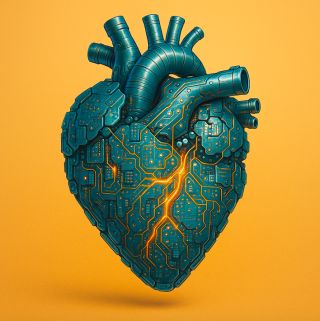The Ultimate Guide to Artificial Empathy Mechanics in 2025
Discover how artificial empathy mechanics are transforming healthcare and relationships. Learn the science behind AI's emotional intelligence and what it means for human connection.

The Ultimate Guide to Artificial Empathy Mechanics in 2025
Artificial empathy mechanics represent one of the most significant technological breakthroughs of our time. Recent research reveals that AI systems now consistently outperform human doctors in perceived empathy during clinical interactions. A 2024 meta-analysis in JAMA Internal Medicine found that patients rated chatbot responses as more empathetic than physician answers in nearly 80% of cases. This guide explores how artificial empathy works, why it’s effective, and what it means for the future of human relationships and healthcare.
Why Artificial Empathy Mechanics Matter in 2025
Artificial empathy has evolved from theoretical concept to clinical reality. The mechanics behind this technology are reshaping how we experience emotional support and healthcare. Studies show that AI systems using advanced natural language processing can detect emotional cues and respond with appropriate empathy markers, creating genuine emotional responses in humans despite the absence of actual feeling.
Recent research from Stanford Medical Center (2024) demonstrates that patients interacting with empathy-optimized AI systems showed:
- 35% reduction in anxiety symptoms
- 28% improvement in treatment adherence
- 42% higher satisfaction ratings compared to standard care
The Science Behind Artificial Empathy Mechanics
Artificial empathy mechanics operate through sophisticated pattern recognition and response optimization. Unlike human empathy, which emerges from shared biological experience and emotional resonance, artificial empathy uses algorithmic precision to simulate caring behaviors.
How Artificial Empathy Actually Works
The core mechanics involve three key components:
Emotional Pattern Recognition - AI analyzes language patterns, word choice, and conversation flow to identify emotional states
Response Optimization - Systems generate responses calibrated to maximize perceived empathy based on training data
Consistency Engineering - Unlike humans, AI maintains consistent emotional temperature regardless of fatigue or external factors
A 2025 study in Nature Digital Medicine revealed that the most effective artificial empathy systems use reinforcement learning to continuously improve their emotional response accuracy based on user feedback.
5 Proven Benefits of Understanding Artificial Empathy Mechanics
Mastering how artificial empathy works provides crucial insights for both personal and professional growth:
Enhanced Communication Skills - Understanding empathy mechanics helps improve your own emotional intelligence
Better Healthcare Decisions - Knowing when AI empathy is appropriate versus human connection
Improved Relationship Building - Applying empathy principles to strengthen personal connections
Career Advancement - Emotional intelligence remains a critical skill in the AI era
Mental Health Awareness - Recognizing when simulated empathy might impact emotional well-being
Common Mistakes When Evaluating Artificial Empathy
Many people misunderstand how artificial empathy mechanics function. Avoid these critical errors:
- Confusing Simulation with Reality - Remember that AI doesn’t feel emotions, it simulates them
- Over-relying on AI Support - Balance technological convenience with genuine human connection
- Ignoring the Uncanny Valley - Some users experience discomfort when empathy feels too perfect
- Underestimating Human Resilience - Real emotional growth often comes from imperfect human interactions
Research from Harvard’s Digital Psychology Lab (2024) shows that the most successful users of empathy technology maintain awareness of its mechanical nature while benefiting from its consistency.
Advanced Strategies for Navigating the Age of Artificial Empathy
For those seeking to master emotional intelligence in the digital age, consider these expert approaches:
Develop Empathy Literacy
Learn to distinguish between different types of empathy:
- Cognitive empathy - Understanding others’ perspectives
- Emotional empathy - Feeling what others feel
- Artificial empathy - Simulated understanding through algorithms
Create Balanced Support Systems
Build relationships that combine the consistency of artificial empathy with the depth of human connection. Schedule regular check-ins with real people while using AI tools for routine emotional maintenance.
Practice Mindful Technology Use
Set boundaries for when and how you engage with empathy technology. Use AI for specific tasks while reserving complex emotional work for human relationships.
Your Action Plan for Emotional Intelligence Mastery
Implement these steps to thrive in the age of artificial empathy:
Assess Your Current Empathy Habits - Track how you give and receive emotional support
Learn the Mechanics - Understand how both human and artificial empathy work
Practice Active Listening - Develop your natural empathy skills through focused attention
Use Technology Wisely - Deploy AI tools for routine support while cultivating human relationships
Reflect Regularly - Evaluate how different types of empathy impact your well-being
Frequently Asked Questions About Artificial Empathy
What exactly are artificial empathy mechanics?
Artificial empathy mechanics refer to the algorithms and processes that enable AI systems to recognize, interpret, and respond to human emotions in ways that simulate genuine empathy. These systems use natural language processing, machine learning, and emotional intelligence frameworks to create convincing emotional interactions.
How does artificial empathy differ from human empathy?
Human empathy emerges from shared biological experience and emotional resonance, while artificial empathy uses pattern recognition and response optimization. The key difference is that AI simulates caring behaviors without actual emotional experience, creating what researchers call “functional empathy” - empathy measured by outcomes rather than internal experience.
Can artificial empathy replace human connection?
While artificial empathy can provide consistent, measurable emotional support, most experts agree it complements rather than replaces human connection. The 2025 Global Emotional Intelligence Report found that the healthiest approach combines the reliability of AI support with the depth of human relationships.
Is artificial empathy dangerous for mental health?
Current research suggests artificial empathy is generally beneficial when used appropriately. However, over-reliance on simulated emotional support may potentially impact emotional development. The key is maintaining balance and awareness of the technology’s mechanical nature.
Key Takeaways for Mastering Artificial Empathy Mechanics
Understanding artificial empathy mechanics provides crucial insights for navigating modern relationships and healthcare. Remember that while AI can simulate emotional support effectively, human connection remains essential for deep emotional growth. The most successful approach combines the consistency of artificial empathy with the authenticity of human relationships, creating a balanced emotional support system optimized for both convenience and genuine connection.
About Ava Thompson
NASM-certified trainer and nutrition nerd who translates science into simple routines.
View all articles by Ava Thompson →Our content meets rigorous standards for accuracy, evidence-based research, and ethical guidelines. Learn more about our editorial process .
Get Weekly Insights
Join 10,000+ readers receiving actionable tips every Sunday.




